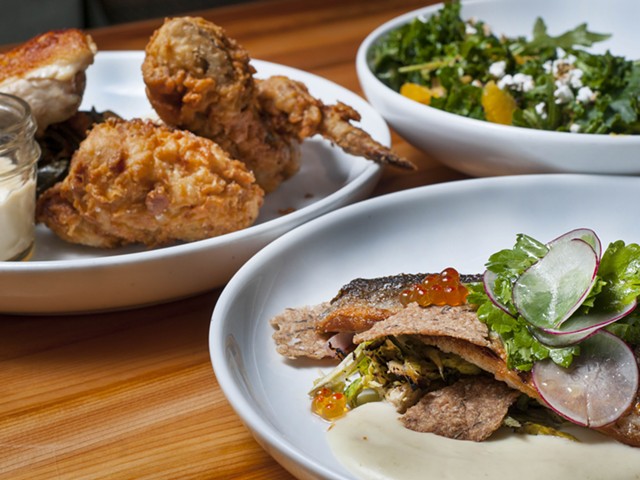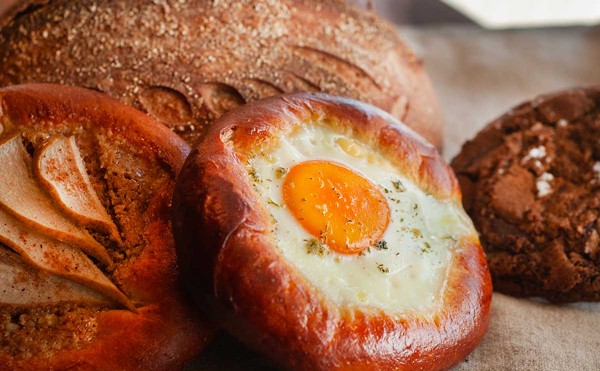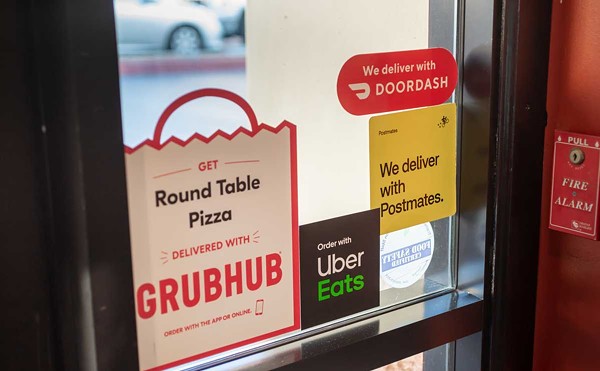Detroit diners generally love small plates and shared some wonderful dishes over the last few years as more local eateries trading in the concept cropped up. But it's refreshing to learn that Gather, a new restaurant preparing to open next month, will head a different direction with the sharing idea.
Instead of small plates, it's big plates. A menu item is enough to feed a party of four to six, and the simple fare is all cooked above "campfire" flames in what's shaping up to be a cozy spot near the Eastern Market.
The three young owners behind Gather grew up together in Macomb County, taking individual paths to restaurateur-ing that influence their ideas and vision. Chef Nate Vogeli worked as an executive chef on a dude ranch in Montana, where the concepts of simple cooking and big, warm hospitality helped shape the idea behind Gather. Lea Hunt worked in coffee shops, at Quicken Loans, and the Detroit Institute of Bagels. Her husband, Kyle Hunt, spent the last several years in the sustainability field with a firm that turns warehouses into landfill-free operations.
Their 34-seat, 2,200-square-foot space (including the basement prep area) sits across Gratiot Avenue from the Eastern Market in one of Detroit's most architecturally beautiful blocks. It's a fine addition to a stretch holding businesses like Trinosophes, Antietam, and Inner State Gallery. We sat down for a conversation about the campfire concept and what led to Gather.
Metro Times: If you had to sum it up in very few words, how would you describe Gather's fare?
Nate Vogeli: It's kind of a fluid concept, but the most laymen term is "New American Woodfire." We like to say something along the lines of "gritty fine dining with a woodfire twist."
MT: You plan to cook above a fire. What are the advantages and why is that important to the concept?
Vogeli: The biggest advantage is flavor. It really tastes awesome. Wood burns at a lot higher temperature than gas does, so you get a better sear, a better char. But it's interesting because it's quite a bit more difficult to work with since you're constantly maintaining the fire and you're constantly connected to the heat source. So I'm looking at the food on the grill, but I'm also looking past the food into the fire and making sure the coals are right and I'm putting wood in.
So it's a very interactive cooking style, and. in some ways, it's easier to put more love in because you're more involved, and you have to tenderly care for it.
MT: How is the menu coming along? What are some of the dishes we can expect?
Vogeli: We've got to get the kitchen set up and do some trial runs still, but instead of a steak, we'll have a big thick roast, bacon-wrapped, so it's like pulled beef with bacon holding it in a steak form, and that'll be seared off.
Lea Hunt: Wings, we'll always have a great burger. Some changes seasonally, the meats will mostly stay the same, but we'll dance around with the vegetables.
We want to do some large format things, so we're trying to steer away from the small shared plates that a lot of places are doing ... If you want, you can have a meal for four to six people. You'll get a full fish, rice and veggies, so that's bringing along the "Gather" thing.
We like when people share with each other, serve themselves off one shared item, but not one tiny plate of something. We're going to work with that and see what works the best. We'll have canned beer ... to keep it simple, and a wine menu that's approachable, affordable, and encourages bottle purchases for sharing.
MT: What inspired the concept?
Kyle Hunt: We all have the knack to and want to take care of people and entertain them.
Lea Hunt: It was very organic. We let the building we found speak to us. We didn't want to be putting a concept into a box that doesn't fit. We knew we wanted a restaurant, we knew we wanted to serve people in the city, but we had to find something that fits for us and makes sense, so it grew out of the building space and the neighborhood more than it grew out of us, and hopefully that bodes well for how we fit in.
MT: Nate, you did something along these lines out on a ranch in Montana?
Vogeli: Yeah, I worked out there in a place with kind of a lodge feel with the ranch and big steaks, and got to see a cool world because they have a little different idea of hospitality, especially on that dude ranch where people stay for a week and you're family. A lot of the families had been coming there for 10 years the same week of the year ... and it was a cool, different atmosphere to see with these big, communal tables and the moose head on the wall, and I got to cook them breakfast lunch and dinner.
It created this idea in my mind of "How can I make this into a restaurant? How do we capture some of that warmness that's genuine ... and how do we bring that in and wrap it into a restaurant concept?" That has been in my mind for a while, and Gather has turned into that more than I ever thought it could.
MT: Why is the communal part of the equation important?
Lea Hunt: We started doing pop-up dinners at one long table and we liked people interacting with each other, not just their party, or having that momentary interaction with others. People like to go to the bar because they sit next to people they don't know. You can bring your first date to Gather ... and have a nice ice breaker!
We also want it to have a community feel and this block is ideal. And we want the community to feel comfortable here, so that all ties in with sitting together. You can't say "Gather" and have people sitting all around at two tops. We want them to have big plates of food and be sharing with each other.
Vogeli: I can't imagine four-top tables in here. It would look like a cheesy diner. You do something like this in here and all the sudden it's a unique space.
MT: This is a beautiful block with a lot going on. How'd you land in this building?
Lea Hunt: We had a bunch of different things fall through and thought we were never going to find anything, then we saw this and we were like, "Ah!" We were just looking everywhere. The Eastern Market was on our radar ... and the pieces started falling.
Vogeli: Once we started paying attention to the Eastern Market's little side streets, and the area, and you see how the food community really is here ... we were like, "This place is perfect!"
It's pretty difficult to pull off farm to table, but market to table we can pull of here, and source everything from our neighbors. That's one of the biggest things that we're excited about.






